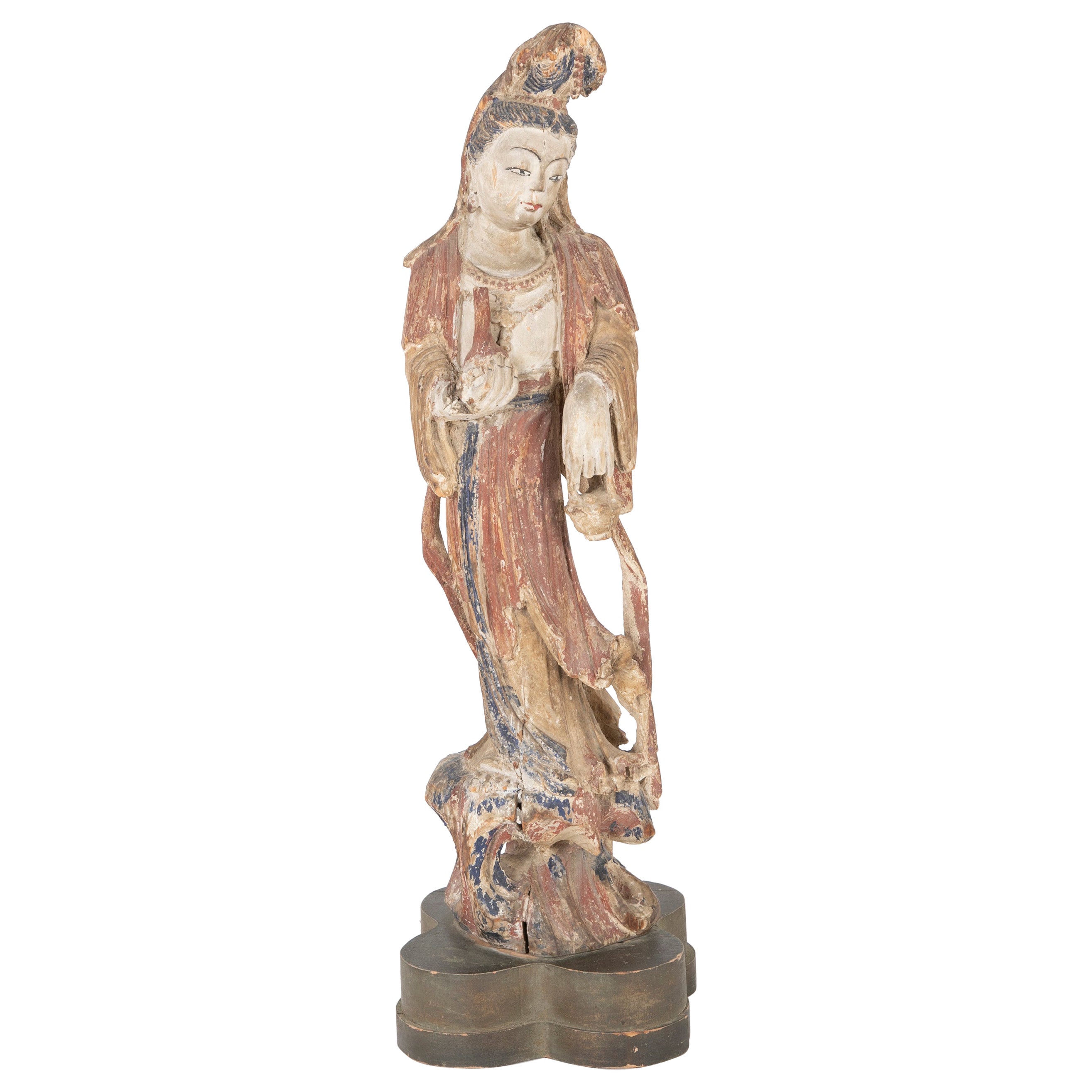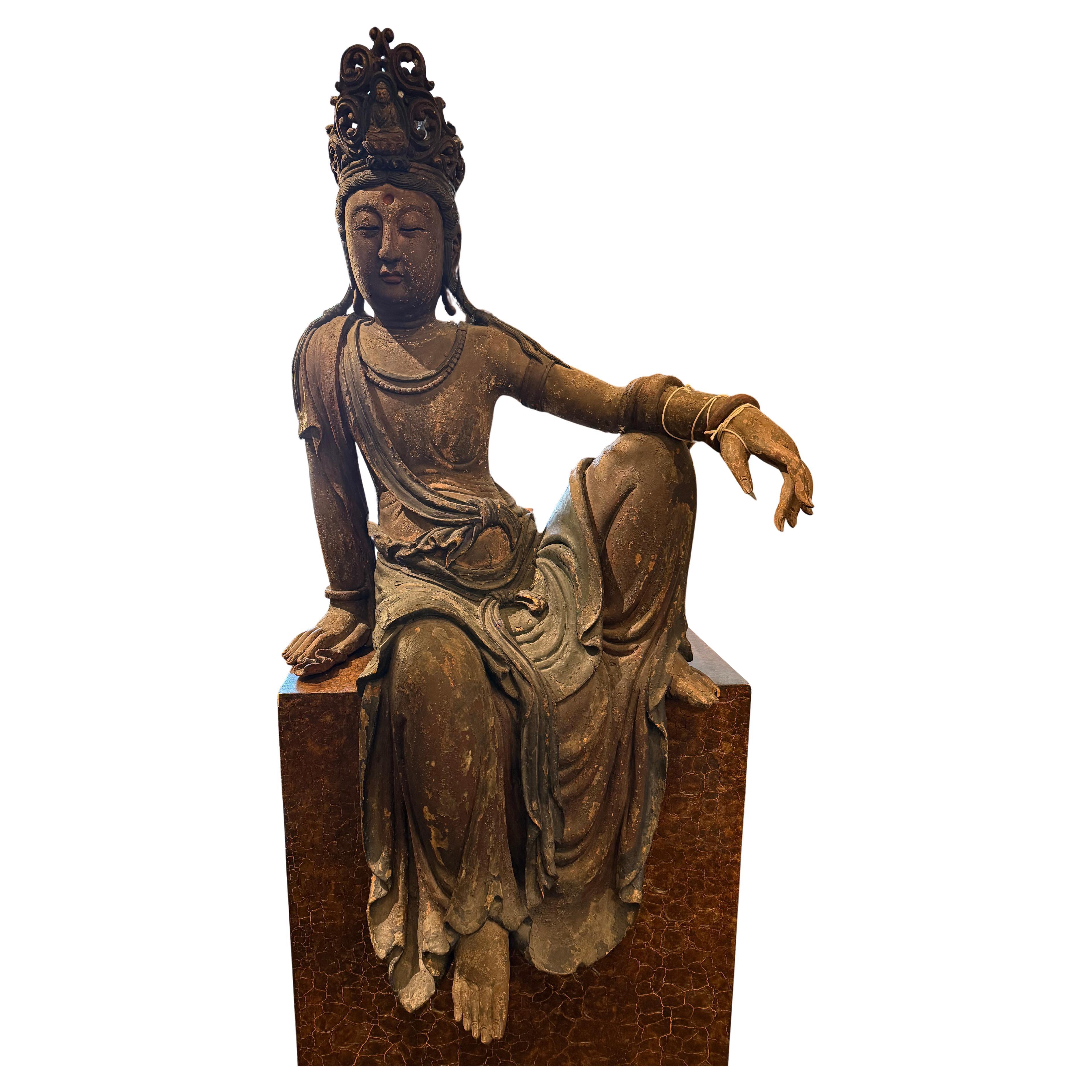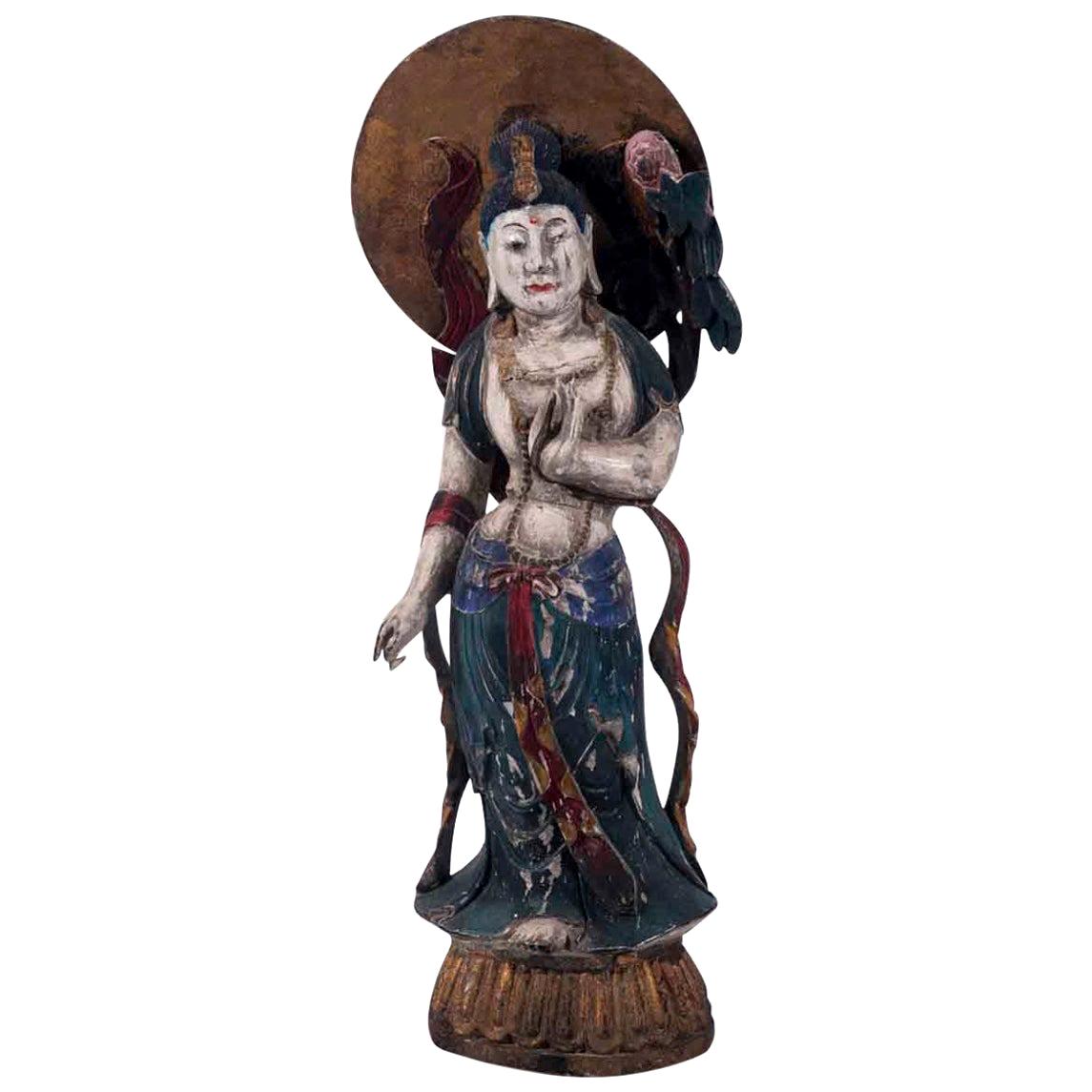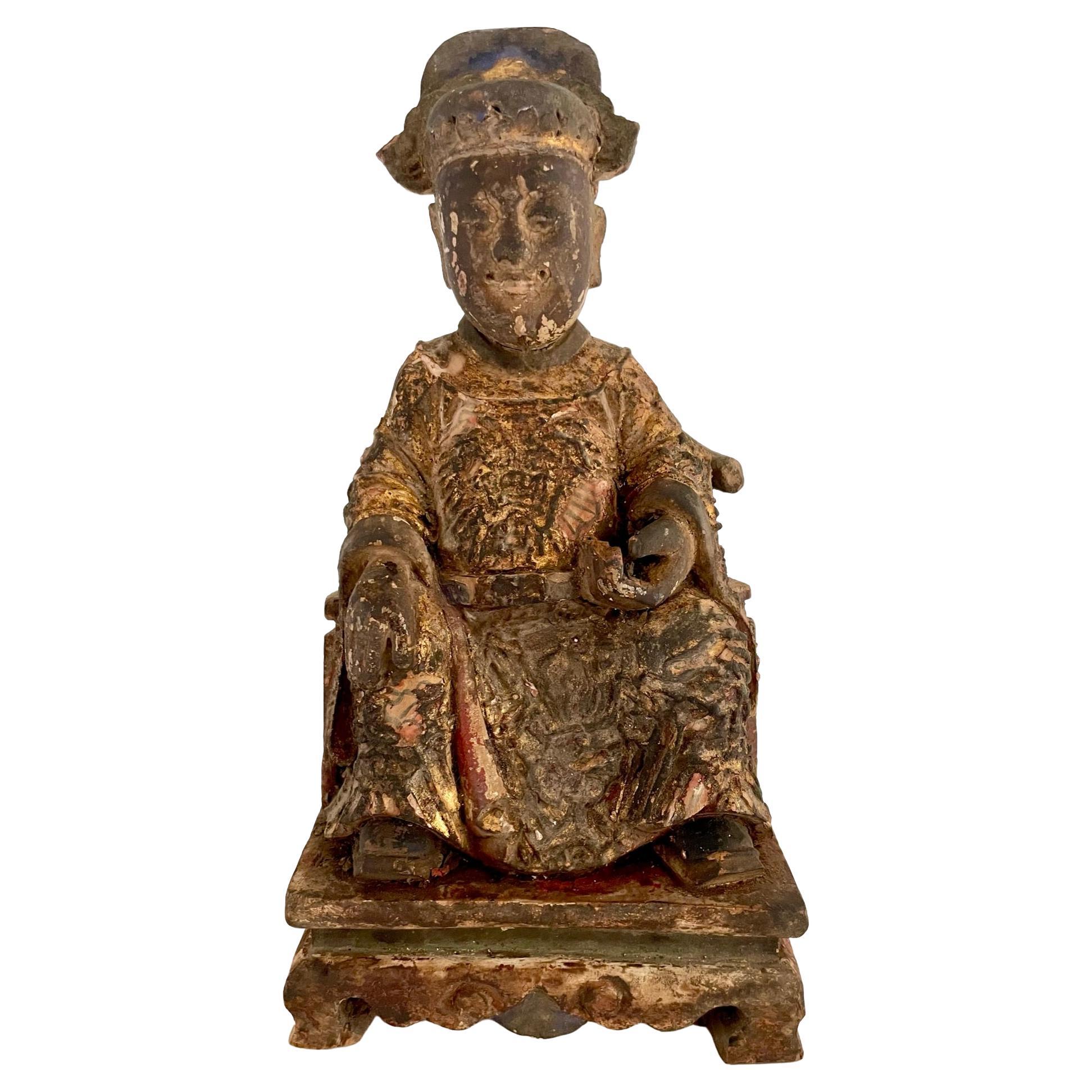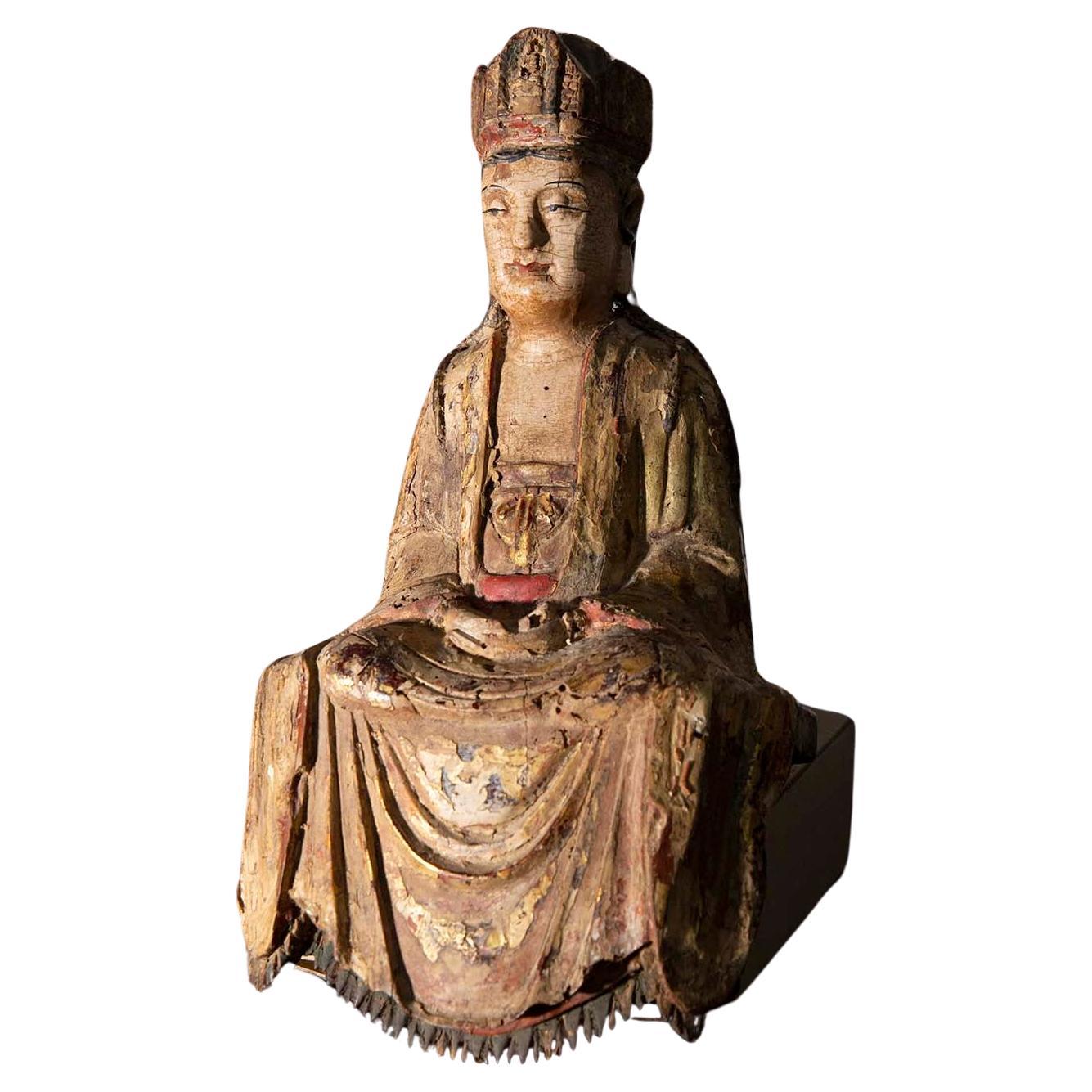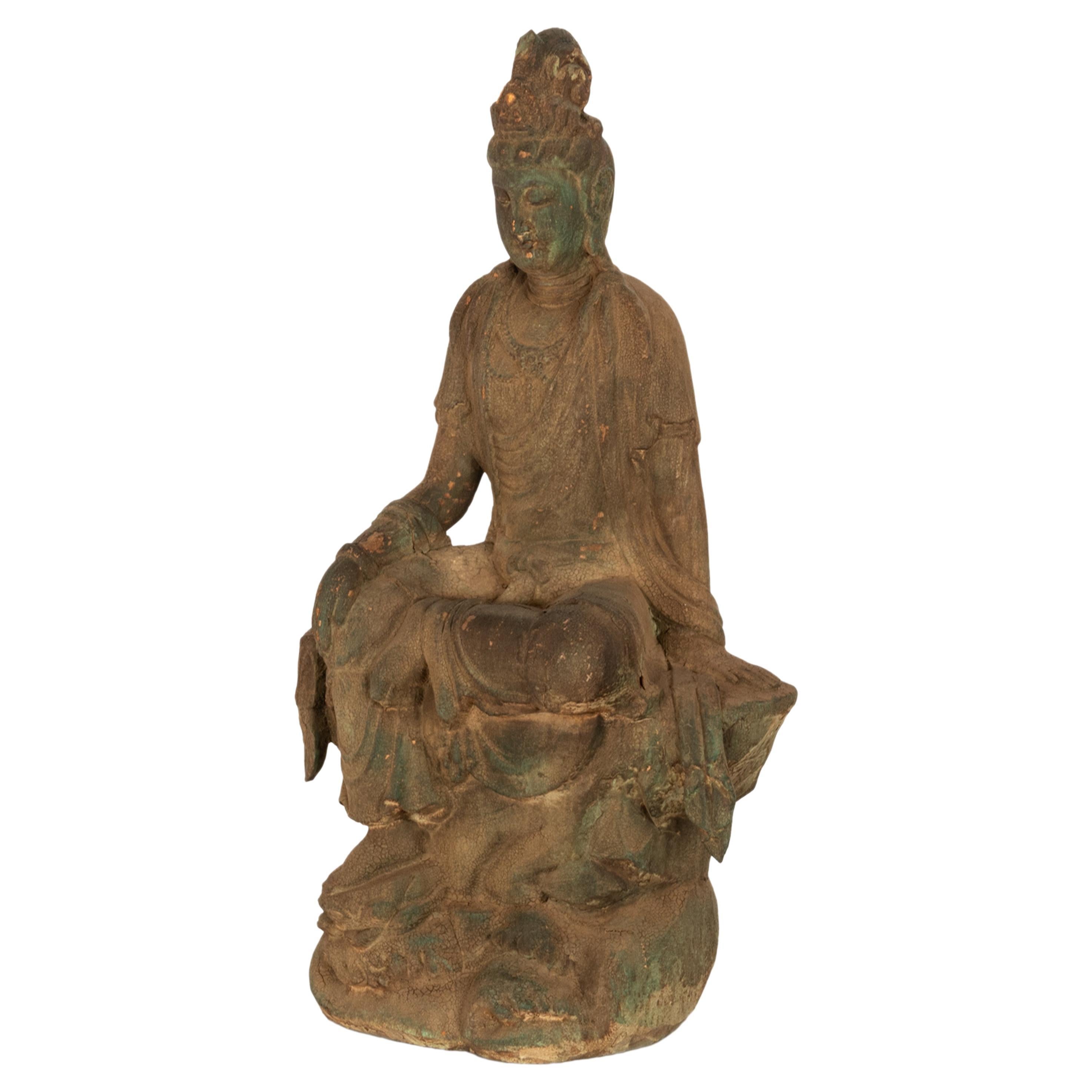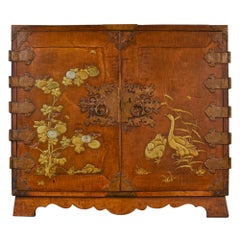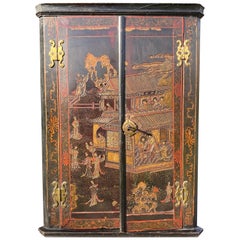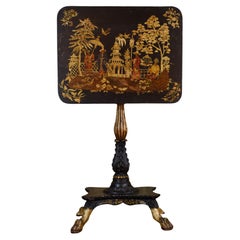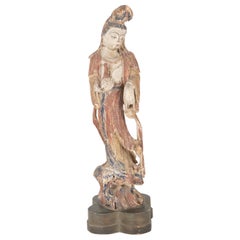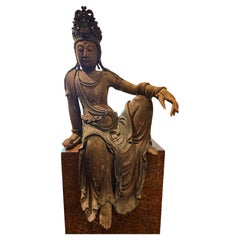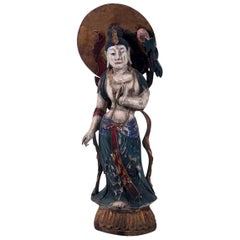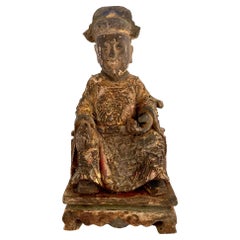Items Similar to Chinese Guan Yin Figure Early Ming Dynasty
Video Loading
Want more images or videos?
Request additional images or videos from the seller
1 of 19
Chinese Guan Yin Figure Early Ming Dynasty
$15,987.31
£11,800
€13,807.19
CA$22,023.58
A$24,665.02
CHF 12,869.80
MX$301,272.58
NOK 163,741.33
SEK 154,345.83
DKK 103,041.34
About the Item
A rare Chinese Guan Yin figure, early Ming dynasty (1368-1644).
Beautifully painted carved wood retaining a significant amount of its apparently original polychrome decoration. Some minor losses entirely consistent with age.
A supremely elegant and serene sculpture.
Nb. Often these early wooden sculptures have been overpainted and stripped many times over the centuries, and finished with a papier mâché reinforcing outer layer. Originally these figures would have been polychrome painted in naturalistic colours and would have served as objects of great veneration in ancient China. Guan Yin (or Kwan Yin) is considered by some to be the most widely beloved Buddhist divinity. She is the female bodhisattva of infinite compassion and mercy in East Asian Buddhism. Her full name is Guan Shi Yina. Guan translates as observe, watch, or monitor. Shi refers to the world. Yin means sounds – specifically the sounds of those who suffer.
As such Guan Yin is perceived as a compassionate being who watches over and responds to those around the world who cry out for help. To be compassionate is the supreme virtue of Mahayana Buddhism. Guan Yin is also associated with vegetarianism – an act of compassion toward animals. Guan Yin was introduced to China as early as the first century AD.
The V & A Museum in London has a superbly conserved Guan Yin with evidence of having been completely redecorated at least four or more times. See V & A, London (Scala Publications Ltd) p. 111, illustration 3.
A similar Guan Yin sold @ £8,600.00, Bonhams, 17th December 2018, lot 272.
- Dimensions:Height: 22.84 in (58 cm)Width: 12.21 in (31 cm)Depth: 9.06 in (23 cm)
- Style:Ming (Of the Period)
- Materials and Techniques:
- Place of Origin:
- Period:
- Date of Manufacture:1368-1644
- Condition:Wear consistent with age and use. Retaining a significant amount of its apparently original polychrome decoration. Some minor losses entirely consistent with its age.
- Seller Location:Lymington, GB
- Reference Number:Seller: BHA 9921stDibs: LU4081133422612
About the Seller
5.0
Vetted Professional Seller
Every seller passes strict standards for authenticity and reliability
Established in 1957
1stDibs seller since 2018
36 sales on 1stDibs
Typical response time: 8 hours
- ShippingRetrieving quote...Shipping from: Lymington, United Kingdom
- Return Policy
Authenticity Guarantee
In the unlikely event there’s an issue with an item’s authenticity, contact us within 1 year for a full refund. DetailsMoney-Back Guarantee
If your item is not as described, is damaged in transit, or does not arrive, contact us within 7 days for a full refund. Details24-Hour Cancellation
You have a 24-hour grace period in which to reconsider your purchase, with no questions asked.Vetted Professional Sellers
Our world-class sellers must adhere to strict standards for service and quality, maintaining the integrity of our listings.Price-Match Guarantee
If you find that a seller listed the same item for a lower price elsewhere, we’ll match it.Trusted Global Delivery
Our best-in-class carrier network provides specialized shipping options worldwide, including custom delivery.More From This Seller
View AllRare Chinese Kangxi Polychrome Coromandel Lacquer Casket
Located in Lymington, GB
A rare Chinese polychrome Coromandel or ‘Bantam Ware’ lacquer casket or table cabinet, Kangxi period (1661-1722). Circa 1700.
This fine small Chinese-export lacquer fitted casket is decorated overall with polychrome incised decoration. Opening with two doors revealing a red interior with fitted drawers and a hinged rising top. In superb, almost entirely original condition, retaining its vivid colours and fine details with courtiers in a pavilion and on horseback amidst foliage and formal palace gardens. The small bun-type feet are historical replacements. Interestingly bearing an antique-script inventory #25 and A I on the base.
Nb. Bantamwork or Coromandel lacquer, not to be confused with ‘japanning’, is the term applied to decoration that is cut into a layer of gesso and then lacquered in colours. Much of the lacquer was transhipped from China through Coromandel in India, or the Dutch colony Batavia, Java.
References:
Coromandel lacquer or 'Bantamwork', with its characteristic incised decoration, was made in Henan province in Northern China from the latter-part of the Ming dynasty and exported to Europe from the end of the 17th Century through the East India Company's and VOC trading posts on the Coromandel Coast of India. The technique consisted in overlaying a base of wood with a series of increasingly fine white clays and fibrous grasses. Over this surface, lacquer was applied and polished before the design was incised and the hollowed out portions filled with colour and gilt and finished with a clear lacquer to protect it.
Although John Stalker and George Parker used the term 'Bantamwork', the contemporary layman usually called it 'cutt-work', 'cutt Japan' or 'hollow burnt Japan'. Stalker and Parker discuss two types of 'Bantam-work' - flat and incised - in their 'Treatise on Japanning and Varnishing' (1688), noting that it 'was done in colors mix't with a gum water'. They also considered that it was 'almost obsolete, and out of fashion, out of use and neglected....' although admitted that 'it was very pretty, and some are more fond of it, and prefer it to the other...'.
This casket/ table cabinet now on offer is related to one formerly with Malletts and illustrated in A. Bowett, 'English Furniture 1660-1714: From Charles II to Queen Anne' (2002) p. 150, plates 5:9.
A much larger yet closely-related Bantam work coffer with rising lid was offered in the 'Asian Art in Cologne' sale lot 114 on 11th December 2021. Estimated @ £ 60,000 - £79,000.
Mme de Pompadour, mistress to King Louis XV from 1745 to 1751, was an avid collector and admirer of Chinese Coromandel or Bantam Work, and was probably largely responsible for the very high prices recorded for such pieces, sometimes 10 times or more the price of ordinary furniture of equivalent quality.
A Coromandel cabinet...
Category
Antique 18th Century Chinese Cabinets
Materials
Lacquer
Fine and Rare 17th Century Japanese Mulberry Wood Gilt-Lacquer Cabinet on Stand
Located in Lymington, GB
An outstanding and rare, 17th-century Japanese mulberrywood gilt-lacquer cabinet raised on a later stand.
This fine and exceptional two-door, gilt-heightened cabinet - reputedly in mountain mulberry wood...
Category
Antique 17th Century Japanese Cabinets
Materials
Lacquer
Early 18th Century Coromandel Lacquer Corner Cabinet
Located in Lymington, GB
An early-18th century Coromandel lacquer corner cupboard or cabinet.
This is rare - high quality Coromandel lacquer work (incised decoration) - not to be confused with the usual English japanned versions.
This is also referred to as Bantam work, originating in Bantam, Dutch East Indies, and China, for export to the European market.
The subject matter is of a major pavilion with numerous courtiers - most unusual to see only females - it has been suggested that they may be concubines to a Mandarin.
All of high quality and in the sought-after and refined chinoiserie taste.
In very good unrestored state, retaining vibrant colours and all its original hardware. This is a chic antique, and makes a lovely chinoiserie drinks cabinet...
Category
Antique Early 18th Century Asian Cabinets
Materials
Lacquer
Fine Rare Regency Chinoiserie Occasional Table
Located in Lymington, GB
A fine and rare English chinoiserie-decorated occasional table, circa 1820.
The subject matter is extremely rare in that it depicts Europeans in exotic oriental robes. One is seated with an opium pipe; displayed in a polychrome romantic tropical environment with pavilions, rockwork, trellising, foliage, palms, with a peacock and HoHo bird at their feet.
Note the very rare and charming depiction of these men with beards. In over 67 years we have never encountered a japanned table showing this European feature.
Raised on a gilded, reeded, partly-ebonised column rising from a stylised platform base and spreading, gilded animal...
Category
Antique 1820s English Chinoiserie Tables
Materials
Wood
Fine Pair of English 18th Century Silkwork Pictures
Located in Lymington, GB
A fine pair of English George III-period silkwork pictures, dated 1797.
These are charming Georgian (late 18th century) needleworks of children play...
Category
Antique 1790s English Decorative Art
Materials
Silk
Large English Regency Chinoiserie Japanned Tôle Tray Table
Located in Lymington, GB
A large English chinoiserie japanned tôle (tole) tray table.
Regency period, early-19th century, circa 1810.
The gilt-heightened exotic landscape set on a Venetian-red ground. Depic...
Category
Antique 1810s English Regency Side Tables
Materials
Wood
You May Also Like
Chinese Carved and Painted Wood Sculpture of Guanyin
Located in Stamford, CT
Beautiful carving of Guanyin, shown standing on a rocky outcrop, mounted on a lobed wooden base. It was once used as a lamp, and can be rewired. Nice faded painted surface.
Guany...
Category
Early 20th Century Chinese Ming Sculptures and Carvings
Materials
Wood
An Important Chinese Carved Wood Figure of Guanyin, Ming Dynasty, 17th Century
Located in ARMADALE, VIC
An Important Chinese Carved Wood Figure of Guanyin, Ming Dynasty, 17th Century
Description:
A dignified portrayal of the bodhisattva, respl...
Category
Antique 17th Century Chinese Ming Sculptures and Carvings
Materials
Wood
20th Century Carved Guan Yin
Located in Houston, TX
A tall 20th century polychrome carved Asian standing Guan Yin. She is depicted on a lotus pedestal and robed with ribbons and beading, surrounded by a parasol styled moon.
Category
20th Century Asian Figurative Sculptures
Materials
Wood
18th Century Chinese Carved Wooden Alter God
Located in Atlanta, GA
This Chinese carved polychrome seated altar god was once used on the family altar to honor their ancestors. Ancestor worship plays a major role in Chinese religion. This beautifully...
Category
Antique Late 18th Century Chinese Sculptures and Carvings
Materials
Wood
Polychrome wooden statue depicting Guanyin Bodhisattva, Ming, 16th century
Located in Milano, IT
In a realm where time stands still, there exists a 16th-century masterpiece, a sculpture of unparalleled beauty that transports you to the heart of the Ming dynasty. Here, in a place of reverence and artistry, sits the Chinese Bodhisattva Guanyin, the embodiment of compassion, enshrined in a form of breathtaking elegance.
Guanyin's divine presence is unveiled as he is seated in padmasana, the lotus position, a symbol of purity and enlightenment. His regal robes...
Category
Antique 16th Century Chinese Ming Sculptures and Carvings
Materials
Wood
Antique Chinese 18th Century Qing Dynasty Gaunyin Bodhisattva Carved Wood Statue
Located in Portland, OR
A large antique 18th Century Chinese Qing dynasty carved wooden figure statue of the Bohisattva Guanyin.
This wonderful carved statue depicts Quanyin "The one who perceives the sound...
Category
Antique 18th Century Chinese Qing Sculptures and Carvings
Materials
Wood
More Ways To Browse
17th Century Wood Carving
Chinese Wooden Carvings
Asian Polychrome Wood
Chinese Carved Wood Figure
Chinese Female Figures
Ming Chinese Figures
Carved Wood Chinese Figures
Ming Dynasty Sculpture
Bodhisattva Chinese
Ming Figure
Chinese Carved Wood Animal
15th Century Wood Carving
Chinese Polychrome Carved Wood
17th Century Watch
Ming Dynasty Figures
15th Century Polychrome Sculpture
Chinese Carving Polychrome
Guan Yin
